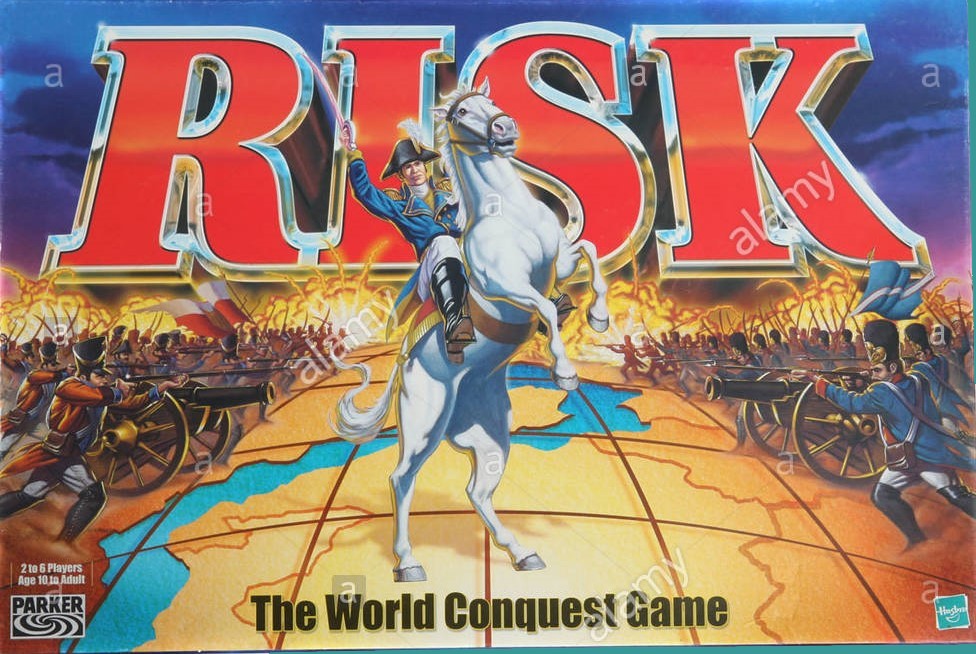Risk

THE EQUIPMENT
Game Board: The Risk game board is simply a map of 6 continents divided into 42 territories total. Each continent is a depicted with a different color and each contain 4 to 12 territories within its borders. The numbers along the bottom or southern edge of the board indicate the number of armies you will receive for a set of cards you trade in.
Armies: There are six complete sets of armies, each containing 3 types:
Infantry = 1 army
Cavalry = 5 armies (infantries)
Artillery = 10 Infantries or 2 Cavalries
The game starts with infantry pieces, however later in the game you may trade these pieces for Cavalry or Artillery (or Calvary for Artillery) according to their respective values above.
Cards: There are 42 Cards, each marked with a territory and a picture of Infantry, Cavalry, or Artillery. There are two ”wild” cards marked with all three pictures, but no territory; and 12 Secret Mission cards which are used only in Secret Mission Risk. Remove Secret Mission cards if not playing that variation.
THE SET-UP
Risk requires planning before the game can begins. Initial placement of armies determines battles later in the game.
To begin, select a color. Depending on the number of players in the game, distribute number of armies accordingly.
3 players = 35 armies each
4 players = 30 armies each
5 players = 25 armies each
* 2 players distribute armies differently. Classically, players got 50 armies each. However, modern interpretations of the game gives them only 40 armies each and establishes a neutral territory with another 40 armies. These are defensive armies for both players only and never used for offense. When one player attacks the neutral country, the other rolls the dice for that country.
- The initial number of armies should be stacked in front of the players.
- Roll one dice to determine first player. Whomever rolls the highest number begins by taking one infantry piece and placing it on a country, thereby claiming their territory. Play proceeds to the left.
- Now everyone takes turn placing one army on unoccupied territories. Continue until all territories have been claimed.
- Once all the territoires have been claimed, each player places one additional army onto any of the territories they occupy. Continue this until everyone runs out of armies. There is no limit on the amount of armies you can play in any single territory.
- Shuffle Risk cards, place it face down next to the board. This is the draw pile.
- The player who placed the first army also takes the first turn.
THE PLAY
Turns consist of trying to capture enemy territory and defeating your opponent’s armies. Successfully winning battles depends on careful planning and bold moves. To win you must attack when the time is right while fortifying your defenses.
Three Step Turn
- Getting and positioning new armies
- Attacking, if you so choose, by rolling the dice
- Fortification of your position
Getting and Positioning New Armies
At the start of each turn, calculate how many new armies to add to your territories by considering:
- How many territories you occupy,
- The value of your controlled continents,
- The value of the matched sets of Risk cards traded in,
- The territory pictured on the race in card
Territories: At the start of each turn, including your first, count the number of territories you occupy and divide by three (ignoring any remainder). The answer is the total number of armies you are to receive. You will always have at least 3 armies even if you currently occupy less than 9 territories. Ex: if you occupy 14 territories, you get 4 armies.
Continents: At the start of each turn, you will also receive armies for each continent you control. In order to control a continent you must occupy all the territories within it. There is a chart in the lower left hand corner of the game board which defines the number of armies you receive per continent.
Risk Cards
Earning: At the end of a turn which resulted in gaining at least one new territory, you will earn at least one Risk card. The goal of Risk cards is to collect a set of 3 cards: 3 cards of same design (3 infantry, 3 calvary, 3 artillery), one of each of the 3 designs, or any 2 plus a wild card.
Full sets may be turned in at the beginning of your turn or you may wait. But, if you have 5 or 6 cards, you must trade in one set and the second one if it is full.
Trading in Cards for Armies: Matched sets may be traded in for more armies based on the total number of matches traded in. Keep matches face up under the board for quick reference.
First Set 4 armies
Second Set 6 armies
Third Set 8 armies
Fourth Set 10 armies
Fifth Set 12 armies
Sixth Set 15 armies
Following the sixth set, each additional match traded in is worth an extra 5 armies. For example, the eighth set traded in gives you 25 armies.
If any of the territories you occupy are depicted on one of the three cards you will receive an extra 2 armies. Both armies must be placed in the respective territory.
Attacking
After positioning your armies you can choose to attack. The objective of attacking is to capture a territory by defeating all its occupying armies. Battles are fought by rolling the dice. If you do not wish to attack, pass the dice to the player on your left. You may, however, still fortify your position.
You may end an attack or attacks at any time. If you have succeeded in capturing at least one territory, draw a Risk card from the draw pile. No matter how many territories successfully captured, you can only draw one card per turn.
Rules of Attacks:
- You may only attack territories that touch your own or are connected to it by a dashed line.
- You must have at least two armies in the territory you are attacking from.
- You can continue to attack a territory until all its armies have been eliminated, or you can shift your attack to other adjacent territories, attacking as many territories as often as you would like.
How to Attack:
Begin by announcing where you plan to attack and what territory you are attacking from. Roll the dice against you opponent.
- Before you roll, both you and your opponent must announce the number of dice you plan to roll, and both you and your opponent must roll at the same time.
- Attacker, rolls 1, 2, or 3 red dice. The attacker must have at least one more army than the amount of dice they roll.
- Defender, rolls 1 or 2 white dice. In order to roll 2 dice, the defender must have two or more armies in their territory.
Deciding a Battle:
Compare the highest die rolled. If the attacker’s is higher, the defender loses one army. Conversely, if the defender’s is higher, the attacker loses one amy from the territory attacked from. If both rolled more than one die, compare the next highest pair and apply the same rules. In the event of a tie, the defender always wins. Also, the attacker can never lose more than two armies per roll.
Capturing Territories:
After defeating the last enemy army, you come into ownership of that territory and must immediately occupy it. Occupy the new territory by adding at least as many armies as the number of dice rolled in the last battle. You must leave at least one army in the territory you attacked from. During game play, every territory must have at least on army.
Eliminating the Opponent:
If you eliminate an opponent during your turn by defeating the last of their armies, you win any Risk cards they have collected.
- You must trade in your cards if you have more than six, but no fewer than two.
- If drawing a Risk card, from conquering a territory, after wining an opponents cards puts you greater than 6, you must trade in cards on your next turn.
Fortifying Your Position
Every turn can end with fortification. This is considered by some player to be a “free move”. To fortify, move as many armies as you choose from one of your territories to one your adjacent territories. When you move armies, you must leave at least one behind.
Winning the Game
To win the game, you must eliminate all other player and occupy all 42 territories.
Arizona Gay Nude Games









